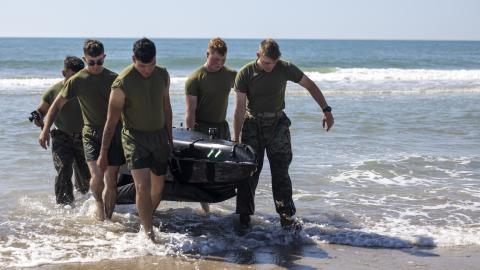Executive Summary
Throughout the second half of the twentieth century and into the twenty-first, America’s military enjoyed broad dominance over the forces of potential and actual adversaries. With the backing of a strong alliance network and the most robust research and development (R&D) base in the world, the US Department of Defense (DoD) developed a worldwide posture and fielded capabilities that were far superior to those of opponents. US forces were able to demonstrate the effectiveness of their Cold War–era R&D efforts through networked, precision-strike warfare in Operations Desert Storm and Allied Force. And although irregular tactics and insurgencies in Vietnam, Iraq, and Afghanistan thwarted US forces’ efforts, analysts largely view those debacles as failures of strategy and employment rather than as shortcomings in the capabilities available to US forces.1
The era of US military dominance is now coming to a predictable end. During ongoing conflicts in Ukraine, the Middle East, and the Caucasus, state and nonstate groups are widely proliferating and employing the sensor, precision weapon, networking, and processing capabilities that the DoD pioneered in the late Cold War.2 Exploiting commercial and military technologies, the US military’s pacing threat, the People’s Republic of China (PRC), has fielded an extensive precision strike network of sensors across every domain that support guided weapons launchers at sea, ashore, and in the air.
Because it boasts the most advanced versions of relevant capabilities and highly proficient operators, the US military remains superior to the opponents it could face in the majority of plausible scenarios. But this lead is narrowing. In some situations and geographies—such as a short-notice invasion of Taiwan by the PRC—US forces would be at a disadvantage and hard-pressed to succeed without risking unacceptable losses.
This study assesses the growing challenges that the DoD faces in countering specific acts of aggression, like an invasion of Taiwan, and proposes a strategic and operational approach to affordably sustain US deterrence. The study starts by describing challenges facing the US military and the DoD’s past use of specialized forces to regain military advantage. For example, when Soviet numerical superiority threatened to overwhelm the North Atlantic Treaty Organization in Central Europe, the DoD turned to nuclear forces as a hedge against a Warsaw Pact invasion.
Chapter 2 builds on these historical examples to define hedge forces generally and how they can lower the risks associated with specific high-consequence, low-probability scenarios in support of an overall dissuasion strategy.3 On its current course, the DoD will continue optimizing the US military to address contingencies, such as a Chinese invasion of Taiwan, to the detriment of capacity for other situations, such as protecting shipping lanes in the Middle East, countering a blockade of Taiwan, or defending NATO against Russian incursions. A hedge force could lower the risks that the US would face during a Taiwan invasion and enable a more flexible US military.
Chapter 3 describes a hedge force designed to address a short-notice Taiwan invasion, and chapter 4 assesses its efficacy using a simulation that compares a hedge force with other approaches for countering PRC aggression. Rather than replacing existing general-purpose forces, the hedge force would complement fighters, bombers, submarines, and other sea- and ground-based missile launchers by slowing and disrupting the invasion to provide more and better target opportunities. By relying primarily on uncrewed systems, the hedge force would be more affordable than growing or improving the general-purpose force and would offer an opportunity to field and experiment with uncrewed systems at scale.
The DoD will need to be creative and adaptable to gain an advantage and deter conflict in a post-dominance era. Hedge forces could reduce the potential losses to US forces and increase the risk for aggressors like China during an attempted invasion of Taiwan. As a result, the DoD could retain more troop formations, amphibious vessels, and aircraft that are less important to stopping a Taiwan invasion but are essential to other operations.
The DoD will face challenges in developing and fielding hedge forces. As a unit without a service to champion it and forward-based far from the DoD’s R&D and acquisition organizations, a Taiwan hedge force will need sustained attention from senior Pentagon leaders to succeed. But recent acquisition and budgeting reforms provide opportunities to pursue this creative approach to managing risk and deterring aggression. If US defense leaders fail to exploit the opportunity, the US military will become a one-trick pony unable to honor its commitments and increasingly marginalized in an intensifying multipolar security competition.
















